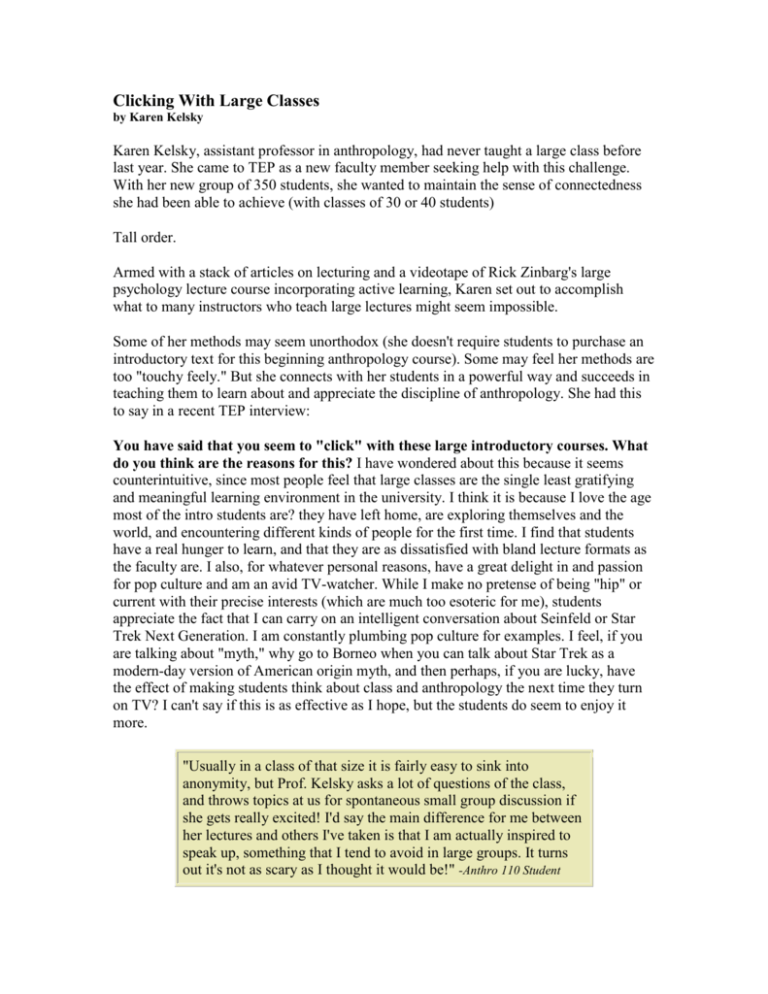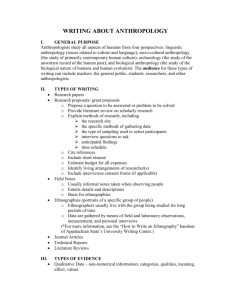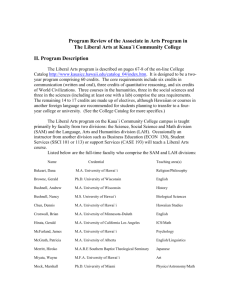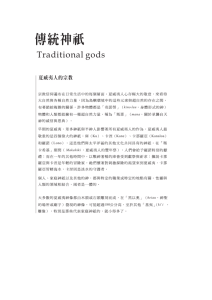Clicking_With_Large_Classes
advertisement

Clicking With Large Classes by Karen Kelsky Karen Kelsky, assistant professor in anthropology, had never taught a large class before last year. She came to TEP as a new faculty member seeking help with this challenge. With her new group of 350 students, she wanted to maintain the sense of connectedness she had been able to achieve (with classes of 30 or 40 students) Tall order. Armed with a stack of articles on lecturing and a videotape of Rick Zinbarg's large psychology lecture course incorporating active learning, Karen set out to accomplish what to many instructors who teach large lectures might seem impossible. Some of her methods may seem unorthodox (she doesn't require students to purchase an introductory text for this beginning anthropology course). Some may feel her methods are too "touchy feely." But she connects with her students in a powerful way and succeeds in teaching them to learn about and appreciate the discipline of anthropology. She had this to say in a recent TEP interview: You have said that you seem to "click" with these large introductory courses. What do you think are the reasons for this? I have wondered about this because it seems counterintuitive, since most people feel that large classes are the single least gratifying and meaningful learning environment in the university. I think it is because I love the age most of the intro students are? they have left home, are exploring themselves and the world, and encountering different kinds of people for the first time. I find that students have a real hunger to learn, and that they are as dissatisfied with bland lecture formats as the faculty are. I also, for whatever personal reasons, have a great delight in and passion for pop culture and am an avid TV-watcher. While I make no pretense of being "hip" or current with their precise interests (which are much too esoteric for me), students appreciate the fact that I can carry on an intelligent conversation about Seinfeld or Star Trek Next Generation. I am constantly plumbing pop culture for examples. I feel, if you are talking about "myth," why go to Borneo when you can talk about Star Trek as a modern-day version of American origin myth, and then perhaps, if you are lucky, have the effect of making students think about class and anthropology the next time they turn on TV? I can't say if this is as effective as I hope, but the students do seem to enjoy it more. "Usually in a class of that size it is fairly easy to sink into anonymity, but Prof. Kelsky asks a lot of questions of the class, and throws topics at us for spontaneous small group discussion if she gets really excited! I'd say the main difference for me between her lectures and others I've taken is that I am actually inspired to speak up, something that I tend to avoid in large groups. It turns out it's not as scary as I thought it would be!" -Anthro 110 Student Talk about why you made the decision not to require an introductory text for your class? Introductory textbooks are very tedious and dull, and in my view, shut down learning rather than open it up. They pack a lot of information in, but don't really spark the mind to think creatively. What I do is lecture from textbook material, but shape it in lecture to my own interests, using lots of good, current examples and interspersing it with questions, comments, stories, discussion, etc. This also accomplishes the goal of requiring students to come to class in order to get basic information. What I use in place of the text is a "reader," which has short excerpts of ethnographies on different themes, each about 5-10 pages long. There are two to three page introductory remarks for each section of the reader, so students still get a rudimentary coverage of vocabulary in "textbook" language, but it is only supplementary to my lecture and doesn't replace it. How do you successfully teach basic concepts of anthropology without requiring an introductory text? Perhaps surprisingly, I have found that my students seem to do well getting basic concepts? to the extent that I have raised the difficulty level of the course considerably. I lecture basic textbook material, and use overheads extensively, with all of the vocabulary and most definitions clearly pre-printed, but with spaces in between to write in examples, etc. The overheads are really the key to the course (I probably use between 5 and 15 each lecture). This year the students are well-trained to write down everything as soon as I put them up there. This keeps them quiet and occupied for a certain amount of time each class, but then gives them the structure to sit back, listen and think about the lecture after they have gotten the basic ideas down. The good students will continue taking notes as the lecture develops in detail and nuance, while the average students content themselves with just the overheads. In this way, I alternate straight lecture with discussion?throwing out questions and talking back and forth with the students. I then feel justified to expect the students to master the overhead material as "minimum knowledge"; the degree to which they can incorporate independent thought or examples from class discussion represents the degree to which they approach a better than average grade. How do you establish a "need to know" with your students to encourage them to be motivated to take the class seriously? I make a really strong pitch the first day and week of class about why anthropology is so critical to being an informed citizen of the university, the town, country, and world. I talk about multiculturalism and discuss current things in the news, like Prop 187 or Prop 209 in California, or English-only laws, or things that people are called upon to think about and vote on that require the ability to confront "difference" in a responsible and non-judgmental manner. I also incorporate my own current reading and thinking from the start, in a way that makes them see that anthro is a lens through which people can constantly make sense of their own lives and work. I picked up a piece of new anthropological writing one day, and found one of the most beautiful, inspiring, impassioned statements about why anthropology is meaningful and important, that I had ever seen. The next day, I just brought the book into class and read the passage. The students seemed moved by it and persuaded. I make this a strong priority of the first week and then continue it throughout the term. In addition to this reader I use two ethnographies, one for the first half, and one for the second. The first ethnography, Number Our Days, is a moving humanistic anthropological study of a group of old Jewish people who are involved in a Jewish community center in Venice Beach California. There is a wonderful Academy-Award winning documentary that goes along with this book. I demand that the students think about this group of people and this book not just as "objects" of study, but really as human beings who are confronting aging and death, and trying to make a good life for themselves. I explicitly state that the point of anthropology is not to be "dry science," but to think humanistically about oneself and others. I try to show the ways that I myself respond emotionally to this material and how it is relevant to my life. This makes things seem more immediate, I think. This year when I promised them a second video based on the book, and then at the last minute replaced it with something else, there was a minor uprising, and a number of students demanded that I show the promised video because they said they were looking forward to seeing it so much. I was shocked, frankly, to discover they were so involved with the material. I rescheduled the video. Talk to us about your use of examples and why this is important. If the basic definitions are the cake, the examples are the icing. They make it all seem relevant. I intentionally choose examples that are NOT from distant spots (although I believe if I had more story-telling talent I could do so and make it work), but rather from today's newspaper. I don't tell stories from my own fieldwork, because I have trouble making them seem relevant to these mainly 18-year-old students who have never been abroad. Rather, I find "difference" closer to home. Since I did my grad school in Hawai'i, I talk a lot about Hawaiians and the Hawaiian Sovereignty movement, tying it to Native American movements on the mainland. I do this as an example during the "language and culture" week, since the Hawaiian language and also Hawai'i pidgin are at the center of contention between Hawaiians and whites (both languages were outlawed and are now making a comeback). Since I have the good fortune to always have several students from Hawai'i in the class, I ask them to come to the front and read some recent works of pidgin poetry, and discuss their experiences being pidgin speakers in Hawai'i and on the mainland. They really enjoy that. I also bring in a boom-box and play some Hawaiian nationalist rap music, showing the lyrics on overheads. This really gets peoples' attention (I play it loud). They are shocked to discover this unpleasant aspect of American history and the rage of native groups against white people, and the fact that all this is going on right under their noses. Since everyone has this idyllic image of Hawai'i, it is quite effective in showing them that culture is a dynamic, contested thing, which is never neutral, but always wrapped up with who has the power. How do you manage to get a lecture hall of 300+ students to be an active learning environment? Aside from trying to use video, poetry and literature and music whenever appropriate, I never lecture for longer than a few minutes at a time, before throwing out questions to the students. If I am talking about the similarities between religion and magic, I won't tell them the differences, I'll ask them what they think the differences are. Then I'll wait while they think, and usually some hands will come up with answers. They aren't always right, but I try very hard to make a constructive response to each. I try to write on the overhead all of the student contributions. About once a week I make the students talk to one another for about 5 minutes. If it is a lecture on ritual, I'll tell them, there are three kinds of ritual: secular, religious, and personal. With the people around you, write down three of each that you regularly engage in. I wander around the room talking to people and listening, and have my four GTFs do so also. Then we come back together and talk about it, with me making the lists on the overhead. There is usually lots of laughter and some "not-so-serious" responses, but I have discovered that if I stay on top of things I can usually "stretch" even the jokes to a legitimate observation about rituals in our lives. Because students know that I try to respond actively to all comments and questions, they seem to be inspired to ask more, but at the same time, to ask questions that are legitimate and thoughtful, and not silly or pointless. How do you deal with the problems of students coming in and out of class during the lecture, talking in the back or reading the newspaper? The reader I use has a wonderful essay by an anthropologist who lectures at the U of Michigan (600 students), which is called "Teleconditioning and the Postmodern Classroom." He has lectured for 20 years now, and has observed these changes in student behavior and analyzes them as being the result of constant television-viewing at home. I won't reiterate his arguments, which are provocative, but I assign it out of order (it is in the language section for week three), and have it read in week one. I make a big point of introducing it in class, and then give an extra credit project for students to read it and write a 1-page single-spaced, typed summary and response to it. This year I got quite a few, about 80, and while not everyone agreed with him, they all were shocked into recognition that what they have taken as common-sense behavior, is actually quite disruptive and not very flattering to anyone. Whether due to the article or not, the class this year is quite disciplined, with very little disruptive behavior. The few students who do walk in and out, I ignore. How do you insure that students will come to class prepared? My discussion sections have 5-minutes quizzes on the readings each week during the first 5 minutes. They are only 3 questions, and only worth 3 points, but missing too many or doing poorly can significantly affect their grades. The questions on the quizzes are as basic as they can be; they only test that students did indeed read the material. The GTFs have the responsibility of making up questions, because I want them varied in each section, so that students can't forewarn one another. This has worked very well in insuring that students keep up on the reading. The other thing is that the readings are, I think, pretty interesting, because they are not from a textbook, as I mentioned. I've had a number of students tell me that they really enjoy readings for the class, and find themselves reading ahead. To return again to Number Our Days, several Jewish students have made a point to tell me that this book has really moved them. You get a lot of positive feedback from students about the course. What seems to work well for them? I try to be as responsive and accessible in class as possible. Also, when students raise a point that I think is important, but which I had not myself thought about, I may say, "What a great idea. I never even thought of that. Let me think about that some more." Then I may come in the next time and say, "I was going to lecture on X, but I've decided to lecture on Y because that was such an important issue that that student brought up last time." It makes students feel that they count, that they are thinking people, with things to contribute. I should point out, however, that my style seems to be one that people either love or hate. I think some people might think it's too touchy-feely. I have had to learn to be more authoritative in the classroom, and to do less to-ing and froing with students, because sometimes the pace of the class would slow waaaaaay down, and I could feel a certain "discontent" in the air. A related point is, that I never under any circumstances read my notes. I glance at them, but I am always watching the students ? actually looking into their eyes ? to monitor their responses. when I see glazed eyes, closed eyes, irritation, annoyance, etc., I try to change tacks, shift gears, and improvise something better. Your name was among the four most frequently repeated by international students when asked to name teachers who made them feel welcomed, valued and respected in class. Can you comment on this? I think a lot of this has to do with the fact that most of our international students come from Asia, and I have spent a lot of time there (5 years), and also in Hawai'i (4 years), which has a strong Asian influence. Plus, my husband is Japanese. So I've gotten a certain "training," in how to try not to be an overbearing white person. I am not always successful in this, but I am perpetually, almost obsessively aware, of the power relations in the classroom, and who is getting to talk and who isn't. In Hawai'i, it was really terrible the way the white students would monopolize the conversation, leaving the foreign students or Asian-American students on the sidelines. I have a real horror of that happening and try very hard to prevent it. This doesn't always work and I am aware that in the end, it is a speaking paradigm that favors white Americans which is the hegemonic one in the university classroom. But I do try to slow things down, allow for silent (thinking) time, quiet down students who talk too much, and gently prod international students to contribute their own thoughts, perhaps drawing from their own cultural background. I do give a spiel in the first week in my smaller, discussion-based classes that talking too much will be downgraded as much as talking too little, and that good listening counts as much as good talking in the overall participation grade, and I try to stick with that. Sometimes, I have to draw a student aside after class and ask them to please restrain themselves and let others talk. But overall, I feel this is something I still need to work on. Lizard 43 Fall 97











